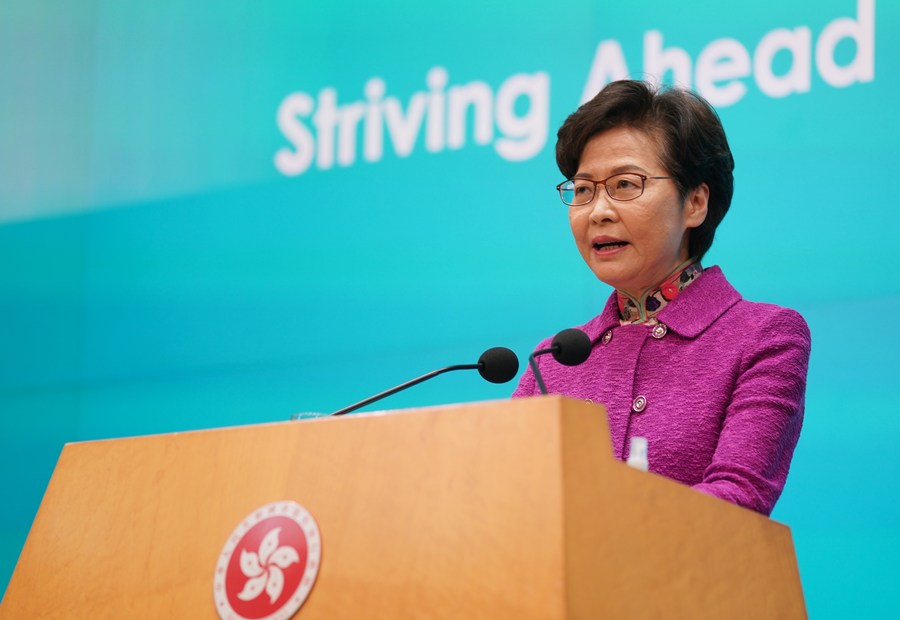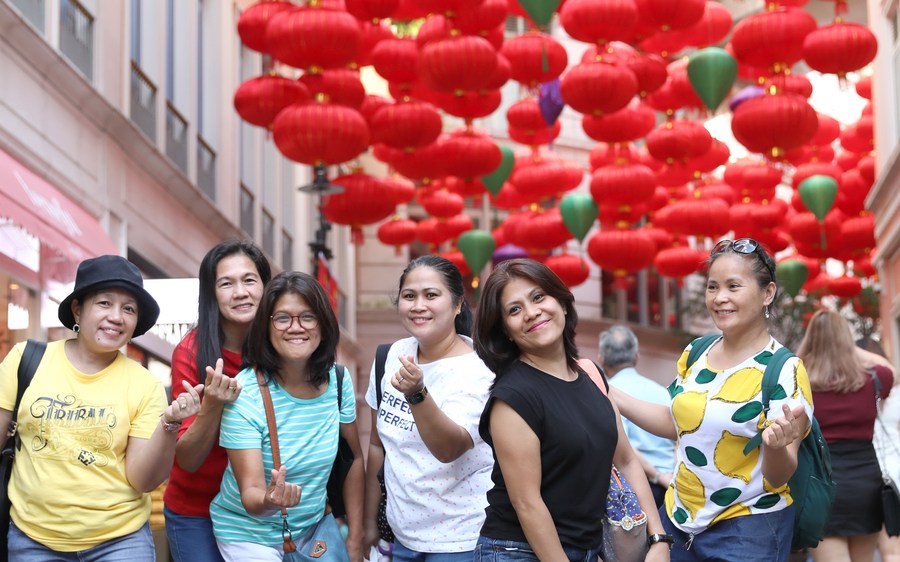Hong Kong embraces greater development opportunities with new policy address unv

Chief Executive of China's Hong Kong Special Administrative Region (HKSAR) Carrie Lam holds a press conference following the 2020 policy address in Hong Kong, south China, Nov. 25, 2020. (Xinhua/Wang Shen)
The support measures unveiled in the new policy address will help Hong Kong better participate in the development of the Guangdong-Hong Kong-Macao Greater Bay Area, consolidate its status as an international financial center and tackle difficulties of its residents.
As a series of support measures were unveiled in the new policy address on Wednesday, Hong Kong, still reeling from social unrest and the COVID-19 epidemic, is expected to gain momentum to revive its ailing economy, integrate into steady development of the country, and realize greater achievements in the future.
Tapping into Greater Bay Area
Observers said the measures to help Hong Kong better participate in the development of the Guangdong-Hong Kong-Macao Greater Bay Area became the major bright spot of the policy address.
With the great support of the central government, Hong Kong should make full use of the opportunities in the Greater Bay Area and actively integrate into the national development landscape so as to enjoy the dividends of the country's robust growth, Hong Kong-based economist Liang Haiming said.
The new measures, among seven aspects of policy support by the central government, were tangible, detailed and practical, Chan Yung, vice-chairperson of the Democratic Alliance for the Betterment and Progress of Hong Kong, said.

Photo taken on Oct. 24, 2019 shows a view of the Hong Kong-Zhuhai-Macao Bridge from the "Ngong Ping 360" cable car in south China's Hong Kong. (Xinhua/Cheong Kam Ka)
Guo Yiming, deputy chairman of the Hong Kong Federation of Journalists, pointed out that further integration into the Greater Bay Area means easier cross-boundary travel, wider mutual financial market access and deepening innovation and technology cooperation, which will enable Hong Kong to break its development bottleneck.
The Greater Bay Area will also provide young people in Hong Kong with a much broader arena, observers said.
According to the policy address, the Hong Kong Special Administrative Region (HKSAR) government will earmark 100 million Hong Kong dollars (12.9 billion U.S. dollars) to subsidize nearly 200 startups of young entrepreneurs in the Greater Bay Area. Some 2,000 Hong Kong college graduates will get the opportunities of working in the mainland Greater Bay Area cities under a government scheme.
As the new policy address highlighted opportunities in the national development, Hong Kong will be able to find new economic growth points, facilitate better development of the young people, and overcome the current impasse, observers said.

Photo taken on June 12, 2020 shows the night view of Victoria Harbour in Hong Kong, south China. (Xinhua/Wang Shen)
Reinforcing financial hub
The policy address also featured an array of measures to consolidate and enhance Hong Kong's status as an international financial center, in particular the further deepening of the mutual access between the mainland and Hong Kong financial markets.
The central authorities will support the gradual expansion of the scope of eligible securities under stock connect programs, including the inclusion of Hong Kong-listed pre-profit biotechnology companies and stocks traded on the mainland Sci-Tech Innovation Board, according to the policy address.
The implementation of the cross-boundary wealth management connect scheme will also be expedited.
Tan Yueheng, permanent honorary president of the Chinese Securities Association of Hong Kong, said the new policies will bolster the sustainable development of financial markets, bring new impetus into the Hong Kong economy and cement Hong Kong's role as a financial hub and a wealth management center.
The further expansion of stock connect programs will help ensure the continued resiliency, vibrancy and attractiveness of Hong Kong's capital markets, Laura Cha Shih May-lung, chairperson of Hong Kong Exchanges and Clearing Limited, said.
With the new measures to facilitate mutual access of financial markets, capital flows between the mainland and Hong Kong will be more smooth, Cheng Shi, chief economist with ICBC International, said, expecting more global funds into the mainland markets.

People pose for a photo under red lanterns in a street of Hong Kong, south China, Oct. 2, 2020. (Xinhua/Wu Xiaochu)
Addressing people’s concerns
With concrete measures tackling difficulties of Hong Kong residents, the policy address received a positive response from observers and political figures.
As people suffering from a battered economy had warm anticipation for the policy address, the HKSAR government did respond to the public concerns and put forward targeted measures, including pro-employment policies, Chan Yung said.
The government plans to make infrastructure investment of more than 100 billion Hong Kong dollars each year and continue to push forward the Job Creation Scheme, under which 10,000 jobs have been filled in public and private sectors, remarkable progress to realize the 29,000-job targets.
"Such tangible measures will be a great encouragement to the public," Chan said.
Guo Yiming described new measures on housing and land as a breakthrough of the policy address and said a solution to Hong Kong's entrenched housing problem has taken shape.
According to the policy address, the government has identified 330 hectares of land required to meet the demand for about 301,000 public housing units in the coming 10 years, and low-income families waiting for public rental housing will be granted cash allowance.
The measures showed the resolve of the government to revive the economy and improve people's livelihood, Chong Tai-leung, associate professor of the Chinese University of Hong Kong, said.